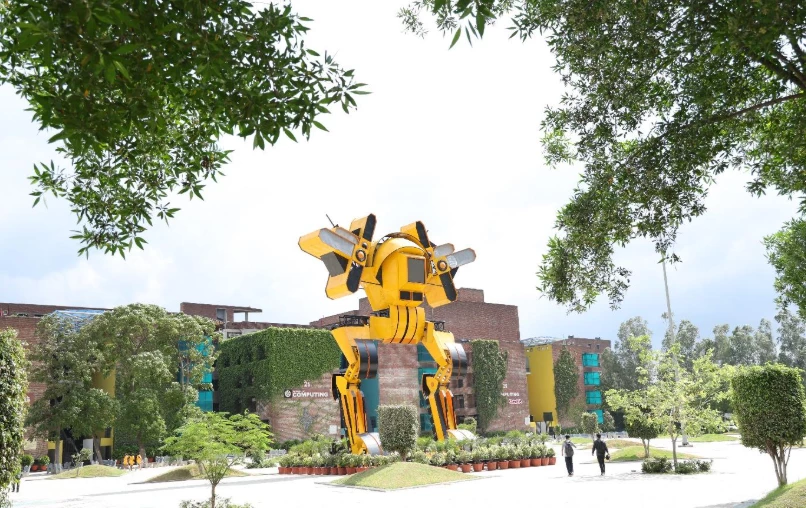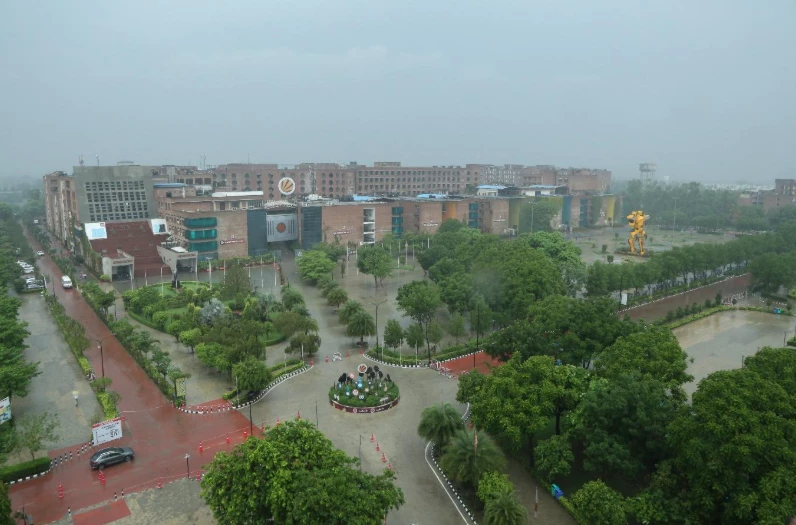Terrestrial Ecosystem Overview
Terrestrial ecosystems differ from aquatic ecosystems in that soil rather than water is present at the surface, and plants extend above this soil/water surface in terrestrial ecosystems. Water availability varies greatly throughout terrestrial habitats (including water shortages in certain circumstances), but water is rarely a limiting factor for life in aquatic environments. Terrestrial ecosystems often endure higher diurnal and seasonal temperature changes than aquatic ecosystems in similar regions because water cushions temperature swings. Terrestrial ecosystems are especially important in attaining SDG 15, which calls for the conservation, restoration, and sustainable use of terrestrial ecosystems.
What is an Ecosystem?
An ecosystem is made up of all the species that interact with their physical surroundings (or ecological system). Nutrient cycles and energy fluxes connect these biotic and abiotic components. A.G. Tansley created the word "ecosystem" in 1935. It is derived from the Greek word oikos, which means "home." An ecosystem is a population of living species in a specific place that coexist with non-living components. An ecosystem might be as small as a desert oasis or as large as the ocean.
What is the Terrestrial Ecosystem?
A terrestrial ecosystem is a population of creatures on land that includes the interplay of biotic and abiotic components in a specific location. The kind of terrestrial ecosystem present in a specific location is determined by the temperature range, average precipitation, soil type, and quantity of light received.

Terrestrial Ecosystem Examples
Examples of terrestrial ecosystems include the tundra, taigas, temperate deciduous forests, tropical rainforests, grasslands, and deserts.
Fun Facts about Terrestrial Ecosystem
Life on the tundra is difficult. The Arctic contains nearly all of the tundras of the Northern Hemisphere. Antarctica, which is located in the Southern Hemisphere, has small tundra-like regions. The tundra is a vast, treeless area. It accounts for around 20% of the Earth's surface. Trees cannot grow in the ground because it is regularly and permanently frozen. The Arctic tundra is home to polar bears, foxes, and reindeer.

Characteristics/Features of Terrestrial Ecosystem
The following are some of the characteristics of terrestrial ecosystems-
- Each of the Earth's terrestrial biomes has its own unique set of weather patterns and temperatures.
- One may get a sense of how significant abiotic variables are in biome distribution by comparing yearly precipitation totals and variations from one biome to the next.
- Daily and seasonal temperature fluctuations are also important in establishing the biome's geographic distribution and plant types.
- The distribution of these biomes shows that the same biome may be located in geographically distinct locations with comparable weather.
Read more about the Multidisciplinary Nature of Environmental Studies.
Types of Terrestrial Ecosystems
There are several types of terrestrial ecosystems that are found throughout the geological zones. The following table gives details about the various types of terrestrial ecosystems-
Types | Description | Examples | Common Animals Found | Common Vegetation |
Desert | The desert is a desolate section of the terrain with harsh temperatures and little flora. Deserts are divided into hot and cold deserts based on their climate and temperature. There are numerous people who have adapted to living in the desert. | The Sahara Desert is an example of a hot desert, characterized by high temperatures, limited rainfall, and a challenging existence for both plants and animals. Ladakh is a chilly desert located on the eastern border of Jammu and Kashmir, near the Great Himalayas. | Camels, foxes, hyenas, jackals, scorpions, and a few snakes and lizards are among the animals. | Acacia, cactus, and date palms are common vegetation. |
Forest | They provide a natural environment for a diverse range of living creatures and have the highest species diversity. Forests encompass roughly 30 to 35 million square kilometers of the earth's surface and are home to over 300 million plant and animal species. | Temperate deciduous forests, plantation forests, and tropical rainforests are all examples of these ecosystems. | Rabbits, foxes, raccoons, squirrels, chipmunks, and badgers are all common. | The primary vegetation in this environment is trees. |
Grasslands | Grasslands are the most common form of vegetation, and they may be found naturally in many places around the world. These terrestrial environments are home to a diverse range of animal species. | Temperate grasslands, including the Eurasian steppes, the North American prairies, and the Argentine pampas. The scorching savannas of Sub-Saharan Africa and northern Australia are examples of tropical grasslands. | Insects, Rodents, and Reptiles | The principal crops farmed on plantations are areca nut (betel nut), cardamom, cashew, cocoa, coconut, coffee, oil palm, rubber, and tea. |
Tundra | Tundra refers to arctic regions that have extreme climatic conditions akin to deserts and are typically windy, snow-covered, and treeless. In comparison to deserts, this type of environment is totally covered with frozen soil all year, and in the summer, the snow melts, and small ponds form. | Tundra ecosystems can be found in polar locations. | The tundra is home to small animals such as Norway lemmings, arctic hares, and arctic ground squirrels, as well as big mammals such as caribou (Rangifer tarandus) | This produces lichens and a few plants with tiny, bright blooms. |
Read more about Thallophyta and Bryophyta.

Terrestrial Ecosystem Organisms and Processes
Organisms in terrestrial habitats have adaptations that allow them to receive water when the entire body is no longer bathed in that fluid, as well as mechanisms for conveying water from limited acquisition sites to the rest of the body and limiting the evaporation of water from body surfaces. They also have characteristics that offer body support in the atmosphere, which is a far less buoyant medium than water, and other characteristics that allow them to tolerate the temperature, wind, and humidity extremes that define terrestrial environments. Finally, species in terrestrial habitats have developed a variety of strategies for delivering gametes in situations where fluid movement is ineffective as a transport medium. This is an example of a terrestrial ecosystem.
Also read more about Water Conservation and Disadvantages of Dams.
Impact of Terrestrial Ecosystems on Environment
- Water shortage (in comparison to aquatic habitats) and the significance of water as a limiting element as a result.
- Many of the water systems that sustain ecosystems and an ever-increasing human population are under stress.
- Rivers, lakes, and aquifers are drying up or becoming contaminated to the point of impracticality.
- More than half of the world's wetlands have disappeared.
- There are greater diurnal and seasonal temperature variations.
- Some ecosystem functions are likely to fluctuate when climate changes and species are wiped out of a region; this might entail higher soil degradation, changes in agricultural productivity, and a decrease in the quality of water available to human populations.
Read more about the Father of Botany and the Father of Biology.

Terrestrial Ecosystem Plants and Size
- Terrestrial ecosystems cover 55,660,000 square miles (144,150,000 square kilometers), or 28.26% of the Earth's surface.
- Members of the division Magnoliophyta (flowering plants), which contains around 275,000 species, and the division Pinophyta (conifers), which has approximately 500 species, are major plant taxa in terrestrial ecosystems.
- Members of the Bryophyta division (mosses and liverworts), which has over 24,000 species, are also significant in some terrestrial ecosystems. In terrestrial ecosystems, major animal taxa include the classes Insecta (insects) with around 900,000 species, Aves (birds) with 8,500 species, and Mammalia (mammals) with roughly 4,100 species.
Read more about the Father of Science and the Father of Zoology.
Terrestrial Habitat Animals
Terrestrial animals are creatures that typically dwell on land. These animals often acquire characteristics based on where they reside in the wild. These characteristics are as follows-
Desert Animals
Animals like camels and rodents, have thick skin and water-storing organs in their bodies.
Arboreal Animals
They have bent bodies and muscular chests that allow them to climb and move between branches. Arboreal creatures include squirrels and chameleons.
Fossorial Animals
They are creatures that dwell in subterranean burrows. Their front legs are short, and their heads resemble thick sticks. Animals that dig holes include rats and rabbits.
Cursory Animals
These animals usually dwell or move on hard, open ground and have powerful legs. For instance, horses and deer.
Aerial Animals
These animals' forelimbs are frequently streamlined and formed into wings.
Read more about What is Wildlife Century?
Terrestrial Habitat Plants
A plant that grows on or from the ground is known as a "terrestrial habitat plant." Most of the time, these plants are classified based on their appearance.
Mesophyte
A plant that can thrive with a little water. It also maintained a healthy plant's root, shoot, and vascular structure.
Xerophytes
The majority of xerophytes are found in deserts, where the temperature is dry and the environment is hot. The thick, fleshy section of their stems held water. It has tiny leaves that aid in the slowing of water loss.
Read more about the Living Things Definition.
Sustainable Management of Terrestrial Ecosystems
- Terrestrial ecosystems underlies the majority of our progress, from raw resources to food production.
- Forests encompass 30% of the Earth's land area, provide oxygen and habitat for many terrestrial animals, and act as a substantial carbon sink.
- Between 2010 and 2015, the annual loss of wooded area was less than half of what it was in 1990, but 12 million hectares of forest are lost each year, and biodiversity is declining at alarming rates.
- Forest ecosystems are critical for the protection of water resources, as well as the development of several novel treatments and active ingredients.
- With today's technology, an expanding human population will demand more cultivated fields, but this should not come at the expense of wooded regions, especially as climate change exacerbates desertification.
Points to Remember
- An ecosystem is a community of living species that exist and interact with one another.
- Plants found in terrestrial habitats are divided into two groups: xerophytes and mesophytes.
- Aerial, Cursorial, Fossorial, Arboreal, and Desert animals are the five groups of terrestrial environment animals.
- The terrestrial environment has four further types of ecosystems: grassland, deserts, woods, and tundra.
- Mountain ecosystems include the tundra terrestrial habitat.
Lovely Professional University, Jalandhar Popular Courses
Average Fees
₹14,40,000
Highest Package
-
Admission 2025
View BrochureAverage Fees
₹8,13,500
Highest Package
-
Admission 2025
View BrochureAverage Fees
Get Fees Details
Highest Package
-
Admission 2025
View BrochureTop Recruiters
 infosys
infosys
 Deloitte
Deloitte
 Wipro
Wipro
 Canara Bank
Canara Bank
 Aon Corporation
Aon Corporation
 Pepsi Food Ltd.
Pepsi Food Ltd.
 Tech Mahindra
Tech Mahindra
 Sasken Communications
Sasken Communications
 Convergys
Convergys
 Asian Paints
Asian Paints
 Eli Lilly and Company
Eli Lilly and Company
 Genpact
Genpact
 TCS
TCS
 Accenture
Accenture
 IBM
IBM
 Reliance communication
Reliance communication
 rbs
rbs
 Igate
Igate
 Nestle India
Nestle India
 L & T INFOTECH
L & T INFOTECH
 Provogue
Provogue
 Dr.Reddy’s Laboratories Ltd
Dr.Reddy’s Laboratories Ltd
 Coca-Cola India
Coca-Cola India
 Vodafone
Vodafone
 INDIA MART
INDIA MART
 evalueserve
evalueserve
 DSCL
DSCL
 Cipla Limited
Cipla Limited
 Airtel
Airtel
 AMW
AMW
 samsung
samsung
 ITC
ITC
 Syntel
Syntel
 Axis Bank
Axis Bank
 Birlasoft
Birlasoft
.png) Glaxo Smithkline Consumer Ltd (GSK)
Glaxo Smithkline Consumer Ltd (GSK)
 MphasiS
MphasiS
 Hexaware
Hexaware
 SOMA
SOMA
 ranbaxy
ranbaxy
 Parle Products Ltd.
Parle Products Ltd.
 SBI LIFE INSURANCE
SBI LIFE INSURANCE
 Ruchi Soya Ltd.
Ruchi Soya Ltd.
 DTDC
DTDC
 ICICI Prudential
ICICI Prudential
 Reliance
Reliance
 Barclays Bank
Barclays Bank
 IIFL
IIFL
 IIFL
IIFL
 Hero Honda Motors
Hero Honda Motors
 Karvy
Karvy
 HDFC Bank
HDFC Bank
 Bank of America
Bank of America
 ICICI Securities
ICICI Securities
 HCL
HCL
 South Indian Bank
South Indian Bank
 Reliance Retail
Reliance Retail
 Google
Google
 Apple
Apple
 microsoft
microsoft
 Yahoo! Software Development Pvt. Ltd
Yahoo! Software Development Pvt. Ltd
 Amazon
Amazon
.png) Hewlett-Packard (HP)
Hewlett-Packard (HP)
 Verizon
Verizon
 DELL
DELL
 Cognizant
Cognizant
 Apple
Apple
 Amdocs
Amdocs
Student's Rating for Lovely Professional University, Jalandhar
Student's Reviews for Lovely Professional University, Jalandhar
Anonymous User
MBA Student
Placement: Lots of placement and internship opportunities were provided
Faculty: Well Experienced and very helpful !!
Admission: Admission in any programme depends on qualifying the Eligibility criteria for that programme. So, first of all decide the programme that you want to join and check its Eligibility criteria for Admission. LPU conducts LPUNEST for all the programmes. LPUNE
Anonymous User
MBA Student
Admission: Register on admission.lpu.in by filling in your details. Select your course as per your eligibility. Apply for LPUNEST to avail scholarship or make direct payment of admission fees. Select desired city and date of exam for LPUNEST. Appear for LPUNEST. Awa
Anonymous User
MBA Student
Placement: To provide good placements, the college also takes much focus on soft skills, and it’s mandatory for students to pass on soft skills. The faculty also show much interest to accomplish this.The placement records for CSE, ECE, Hotel Management and MBA
Faculty: Faculty is good and well versed in their courses. The study material is updated from time yo time with class tests assignments and projects. Everything is planned and Is scheduled properly. Mid terms and End terms are designed in such a way that you keep
Admission: Based on School / 12th Class Result
Club: Almost all the time there is something or the other going on in the campus. Division Of Student Welfare is Set up which is run by the students.
Anonymous User
MBA Student
Placement: Placements are really good in terms of B.Tech and the highest average in MBA. It really depends on the student, for placement student needs to maintain his her CGPA above 6.9. Many companies visit here about 70 to 100 big small company visit here. Amazon,
Faculty: All teachers and faculty are at least having a master degree, they are really helpful. Varieties, of course, are available here means accept MBBS all courses are here. For every teacher there are 50 students, one can clear his or her doubt at any time. Fo
Club: As everyone know about Chandigarh. It is one the the hub of singers. Every Punjabi singer u can meet here. And yes their are lot of clubs.
Anonymous User
MBA Student
Placement: campus, placements are excellent in the university. Apart from this campus also conducts off-campus interviews for the students. LPU has tied up with many companies for the placements of their student. Every year, many students got placed in the reputed
Faculty: Class timings are not so good. Every day it’s from 9 a.m. to 5 p.m. Class exams are regular. And university exams happen twice. Midterm and End Term. Projects and assignment are also part of daily life. •Teachers are cleared with concept.Method ar
Admission: Based on School / 12th Class Result
Club: Many student societies are available for different topics. You can join in any of it via interview. •All day there are festivals. But main festivals are YouthVibe,Spectra,Magnitude,One India,One World, Athletics meet. •Normal College life is boring bu
Anonymous User
MBA Student
Placement: You do not have to search outside for jobs,companies visit the campus and select the students.
Faculty: The teachers are all well qualified but in this field practical knowledge is more important so our teachers are well experienced in there field,and also will motivate you every time. I love to attend their classes as they teach very well and interesting
Admission: Based on School / 12th Class Result
Frequently Asked Questions
Which of the following is the world’s biggest terrestrial ecosystem?
Ans. Grasslands are the world’s biggest terrestrial ecosystems in their widest sense.
Can ecology be created by humans? If so, how so?
Ans. Yes, the ecology may have been created by humans. For example, zoos, national parks, sanctuaries, and so on might be called artificial or man-made ecosystems.
What benefits do terrestrial ecosystems provide?
Ans. Terrestrial ecosystems provide several advantages, such as habitat for wildlife and plants, food, fiber, fuel, and shelter. Carbon, water, and other nutrients are captured, converted, and released.
What exactly is the terrestrial ecosystem?
Ans. A terrestrial ecosystem is a species-rich community on land that involves both biotic and abiotic interactions. Terrestrial habitats include tundra, taiga, temperate deciduous woods, tropical rainforests, grasslands, and deserts.
How have humans affected the world’s terrestrial ecosystems?
Ans. Human activity is drastically changing the structure and function of terrestrial ecosystems. For example, we are changing the chemical composition of the atmosphere, converting natural landscapes into urban areas, and relocating floral and faunal spe
What exactly is a terrestrial habitat?
Ans. The terrestrial ecosystem is the habitat that supports animal life on land. Mountains, deserts, forests, and grasslands are only a few examples.
Could you give some instances of terrestrial animals?
Ans. Giraffes, spiders, snakes, monkeys, flies, cows, and dogs are among the terrestrial creatures.
Lovely Professional University, Jalandhar Videos
4 VideosContact Details
Lovely Professional University, Jalandhar - Delhi G.T. Road, Phagwara, Punjab (India) - 144411
45XXXXXX91
meXXXXXXin
















.webp)



































